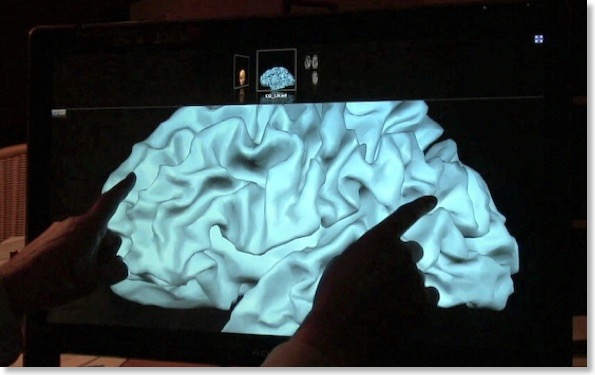Towards 'Minority Report Interfaces': BV Viewer Reloaded
February 12, 2010

The movie “Minority Report” was very visionary in 2002; people remember not only the exciting “pre-crime murder prevention” plot, but also the way how John Anderton (Tom Cruise) interacted with the computer: Images were retrieved, moved, rotated and scaled by simple hand gestures. While hardware for such distant gesture control is not yet widely available (this might change when Microsofts “Natal” system ships), touch-enabled input devices have become very popular in the last years. When Apple announced the iPad two weeks ago, watching gesture-based navigation demo’ed by Steve Jobs was exciting but not surprising since people are familiar with multi-touch gesture control.
While multi-touch gesture navigation is common on phones and some netbooks, it is not available on most laptop and desktop computers. This might rapidly change over the next months and years since Microsoft Windows 7 supports multi-touch screens out of the box. While most Windows applications are not yet optimized for multi-touch input, standard operating system support allows developers to bring the “iPhone feeling” to the large screen. Apple’s Mac OS X also supports multi-touch gesture navigation out of the box albeit limited to the trackpads of Apple MacBook (Pro/Air) laptops.
Multi-touch navigation is, of course, not the best way to interact with a computer in all situations. While virtual keyboards work fine for occasional text input, a good physical keyboard is indispensable for tasks requiring extended periods of text writing. When, however, document browsing, presentation and visualization are the essential features of a program, multi-touch navigation really shines. BrainVoyager Viewer and BrainVoyager Brain Tutor nicely fall into this category and I decided to update them accordingly. The updated BV Viewer program is readily available for download from the BrainVoyager web site.
A short overview of the gesture-based navigation is best provided by seeing it in action. In the first movie shown above, I use BV Viewer on a Windows 7 system and a 22 inch Sony touch screen. In the second movie, shown below, I used the trackpad on a 17 inch MacBook Pro laptop to gesture-control the program. Details about all available options are provided in the updated User’s Guide that is available as a PDF file as well as a set of images that are shown by the program automatically after launch. Furthermore, short instructions are shown when switching input from mouse/keyboard to finger touches. These short instructions can be invoked at any time by pressing the “i” button.
While the movies show that interacting with the two multi-touch system is similar, there are also some noticeable differences. Since most available touch screens for Windows 7 support only two simultaneous touch points, the program’s interface is based on single and two-finger gestures. The two-finger gestures are used to zoom in and out, but may also be used to pan and rotate documents. While it is possible to navigate the program solely on the basis of touch events, mouse / keyboard events and multi-touch gestures can also be easily combined. Since items in folder lists are small and difficult to precisely select by a finger touch, the fonts in selection lists are automatically enlarged when the screen is touched for the first time after launch.
Using the trackpad is less “direct” than finger touches, but it has the advantage to not block the view on the manipulated object. The trackpad supports up to five finger touches, but in the Viewer gestures with two and three fingers are implemented. This allows for a richer set of gestures that is used for three-finger swipes to navigate forward and backward and to switch manipulation modes. Note, however, that the trackpad must be used both for moving the mouse cursor using one finger, and for performing multi-touch gestures with two or more fingers. The position of the mouse cursor is important since all subsequent multi-touch gesture events will be directed to the view below the cursor. The mouse cursor, thus, “links” positions on the trackpad to positions on the screen. On touch screens, there is no such separation of spaces since the gesture is directly performed on a desired view or object on the screen.
To enable an additional means to quickly set manipulation options, a circular context menu has been added in the program that can be seen in both movies. To obtain the context menu on a touch screen, one taps inside a view and waits for a short moment.With a track pad, a “secondary click” (e.g. click with two fingers) has to be performed as specified in System Preferences. The appearing “pie” allows to select a menu item by moving the finger to the respective location; when the finger is released, the selected item is chosen. Such a menu is ideal for touch control since the different options can be reached easily (same distance to center) and precisely. The pie menu contains a “Reset view” item that is useful to clean-up a view. Further options specify whether a two-finger gesture only zooms or also allows to pan or rotate the displayed document.
The multi-touch features of BV Viewer will also be ported to the Tutor program. Even BrainVoyager will benefit from gesture-based navigation in some situations. In addition, a version of the Viewer program for the iPhone and the iPad is currently under development.

